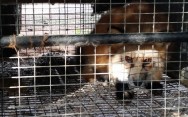Blog Archives
Home -
Archive by category "Animal rights" (Page 3)
Children roaming through the woods with air rifles may sound like dystopian science fiction, but it almost became a reality in New Zealand. Local children were encouraged to compete to shoot feral cats as part of an effort to reduce the population of animals that threaten the ecosystem, and raise money for the local area. Children were encouraged to shoot as many cats as possible for a cash prize of $155.
During the previous year’s event, more than 250 children killed 427 animals, mostly possums, hares and rabbits. Although the cat hunting competition was called off this year, the events in other categories will still go ahead.
The event was canceled partly due to public outrage over the massacre, but also due to dangers to children themselves, and the potential danger to domestic cats. In addition to the cruel murder of feral cats, opponents of the competition pointed out what should be obvious, which is that there is no way to tell for sure whether a target is a feral cat or someone’s beloved pet.
Feral cats are considered an invasive species that threaten native wildlife in New Zealand. Animal rights advocates have stressed that solutions like the cat hunting competition are not a sustainable or effective way of dealing with this issue. Critics argued that it was more about glorifying violence and teaching children to view animals as disposable objects rather than finding a long-term solution to the problem.
One such alternative solution is Trap-Neuter-Return (TNR), a method that has been successfully implemented in many parts of the world. TNR involves trapping feral cats, sterilizing them, and returning them to their colony. This helps to control the population of feral cats without resorting to lethal methods. It also reduces the risk of disease transmission and other negative impacts of uncontrolled feral cat populations. Another alternative is to educate the public on responsible pet ownership and the importance of spaying and neutering cats. This can help to prevent feral cat populations from growing and reduce the number of cats that end up on the streets.
Shooting cats in an inhumane manner with air rifles, may also have caused them to die a more painful death. The obvious violence and suffering felt by animals was intertwined with the grave risk to children both psychologically and physically. Children were not only exposed to dangerous and violent behavior, they were also at risk of injuring themselves or others.
The competition represents a bloodthirsty and unnecessary culture of ‘Man vs Nature’ where children are encouraged from a young age to see themselves as violently dominating the environment and the creatures within it. The controversy may have prevented children from hunting cats, but it has not shut down the competition entirely. Children will hunt animals in a wanton way that will cause great psychological harm to the children and cruelty and suffering to animals.
Humans learn to designate animals like cats or other companion animals higher on a food chain, with humans at the top. We teach our children that humans are separate from animals and nature, and that only some of us have a right to live in freedom from suffering and slavery. Animal rights advocates should celebrate that this cruel event has been canceled, but be careful not to ignore that non-domestic animals remain the victims of cruel hunting and culling, and that children are being taught lessons of cruelty, not compassion.
|
Tags: Animal Cruelty,
Children and Animals,
Education,
Feral Cats,
Hunting,
Kevin Boileau,
Nazarita Goldhammer,
Non-violence,
Psychological Damage,
Transhumanism,
Trap Neuter and Release
There are many reasons why octopus farming should be opposed. Of all the cruel industrial forms of farming that humanity has visited upon our fellow animal species, at least we haven’t yet attempted octopus farming. The world’s first proposed octopus farm will change that, and there are many reasons why that is a very bad thing for octopuses and the environment.
There has been strong global opposition to the proposed octopus farm being built in Spain. The group Compassion in World Farming produced a report to explain why octopus farming should not be attempted. The report states, amongst other things, that Octopus Farming would be an environmental disaster as well as a cruel operation. It would harm marine life in a variety of ways. The method of killing an octopus by putting it in cold water and inducing hypothermia is extremely questionable as a ‘humane” form of killing.
In fact, research from the UK on the sentience of cephalopods concludes that there is no humane way of farming them. The UK introduced laws which recognized their sentience, and the world has been waking up to the fact that cephalopods are extremely intelligent animals. Their difference from humans has been blinding us to their complex and nuanced intelligence, which involves a distributed form of intelligence with several “brains” in their limbs as well as their head. Recent documentaries like “My Octopus Teacher” have pulled back the veil on these fascinating creatures.
Decisions about how we protect animals are so often based on the extent to which they resemble us, or whether they serve us. Research increasingly shows that humans are still very much biased and uninformed about animal intelligence. We see evidence of our bias in favor of creatures like ourselves with large brains, as birds were judged to be less intelligent due to brain size, a theory that is being disproved. This joins growing evidence about the intelligence of animals like insects and bees.
It’s clear that the science concerning creatures other than ourselves reveals more about what we don’t know than what we do know. What it truly reveals is that our current approach to animal rights is based on narcissism rather than compassion, rationality and justice.
The rules about who and what we can kill and exploit are arbitrary benchmarks that reveal more about how little we know than how much we know about animals. The accelerating pace of research about animal lives, intelligence and sociality is toppling these benchmarks to the point that they become absurd excuses for violence. The real conclusion is that, if we still know so little about animals, it provides less, not more justification for our cruelty towards them. Octopus farming will harm a creature that we know to be sentient and most experts have spoken out about it. What more do we need to know?
Please click on the link to sign the petition to stop octopus farming: https://www.drove.com/campaign/6202d5ca01cf365ea19492a3
Many countries and states have been waking up to the need to enshrine the rights of animals and the environments in law. European countries in particular have been setting a trend in passing laws that recognize animal rights and introduce punishments for animal cruelty. What countries are passing these laws and what are the limitations?
Spain
Spain has recently passed laws that increase punishments for animal mistreatment. Amongst other changes, it has also made training classes for dog owners mandatory and made it illegal to leave them for more than 24 hours. In 2020 Spain also passed laws that allowed for joint custody of animals in divorce, recognizing that companion animals were “sensitive, sentient beings” rather than property.
Switzerland
Switzerland is known for having animal rights laws that are stricter than other countries. The right to animal dignity is constitutionally protected. In 2022, Swiss people failed to vote for a law that would have banned industrial farming.
Portugal
In Portugal there is a law that criminalizes abuse and neglect of pets but it has faced challenges because animal protection is not enshrined in the Portuguese constitution.
Netherlands
The Netherlands may soon ban harmful breeding of pets.
What are the Weaknesses of Animal Rights Laws?
One weakness in animal rights laws is who we choose to protect. This means that some animals are considered more worthy of protection than others, for example there are more laws to protect companion animals than lab animals. In the case of Spain’s new animal protection law, people have protested that the animal cruelty laws don’t protect hunting dogs and farm animals. The laws also don’t affect bullfighting, one of the cruelest “sports” involving animals.
The manner in which animal protection laws are introduced often says a lot more about what is acceptable or normal for humans than it does about what animals need or deserve. It’s a positive thing that animal sentience is being recognized in divorce and pet custody. On the other hand, it’s easy for people to understand companion animals as an accessory to human existence. Meanwhile other animals like lab animals, farm animals and invertebrates are frequently under-protected in the law. Many other animals that don’t meet the definition of who humans consider to be intelligent or worth protecting aren’t legally protected. As laws to protect animal welfare proliferate, we need to locate the decision-making process within a new transhumanist framework in which our human perspective is de-centered and animals and ecosystems perspectives are at the center.
The question of whether it should be legal for people to rescue animals from slaughter houses and industrial farms is the subject of a recent New York Times op-ed.
It’s a question that deserves serious consideration. Animal activists have forced the public to confront these questions by filming conditions in slaughterhouses and industrial farms. Their reporting has revealed conditions of unimaginable horror and cruelty, and it has confronted us with our obligation not to be bystanders.
If you are aware of animal abuses committed at large agricultural facilities or slaughterhouses it’s not that simple to do something, however. If concerned citizens want to step in and rescue animals they can face serious charges. The NYT op-ed focuses on the actions of activists at DxE (Direct Action Everywhere) who have gained access to slaughterhouses and revealed abominable treatment of animals. In this case, the activists witnessed chickens at Foster Farms facility who were killed in violent haste. The activists’ infrared cameras showed live birds thrown, crushed and suffocated under piles of dead birds. Many weren’t stunned properly before being killed. There were other reports from U.S. Department of Agriculture inspectors of birds that had been dunked alive in a boiling water tank for defeathering. The activists rescued several animals from the plant, and there are other cases where activists have stepped in and rescued animals from industrial farming facilities and slaughterhouses.
The NYT op-ed made the point that if you saw someone boiling animals alive in your neighborhood, you would feel an obligation to step in and rescue the animals. Why is it any different at a Big Ag facility? There are laws that allow people to rescue dogs from hot cars, yet rescuing animals from cruel industrial farms is charged as theft, and filming the scenes of cruelty can be charged as criminal trespass.
Many of the activists say they are happy to stand trial to help set new precedents for animal rescue. This can pay off, such as in the case of a Utah jury who acquitted two activists of burglary and theft for taking two sick piglets from a Smithfield Farms facility.
This is just the beginning of a process that is stacked against Good Samaritans who want to rescue animals who are being treated cruelly. The bigger problem is that the industrial farming and meat industry will continue to commit cruelty as a matter of course. Industrial farming and the meat industry have sacrificed animal lives to the production line. Rescuing animals from these conditions is the first step towards making society confront what the appetite for industrially farmed meat means for animal lives.
|
Tags: Ag Gag,
Animal Abuse,
Animal Cruelty,
Animal Rescue,
animal rights,
Animal Rights Activists,
Chickens,
Factory Farming,
Kevin Boileau,
Nazarita Goldhammer,
Transhumanism
The slaughter of wild horses is one of the most significant attacks on animals in the US. It hides in plain sight under cover of the BLM’s policy to round up and re-home horses. Animal advocates have obtained documents that show that instead of being adopted, thousands of horses are sold to slaughterhouses.
The slaughter of wild horses is also part of a bigger story about how the US fails to protect horses and willingly allows healthy horses with many happy years of life left to be sold into slaughter.
These problems are connected to the substantial export of horses internationally from the US. The export of horses makes the fate of horses sold into slaughter even more cruel. On top of being violently slaughtered, horses transported internationally have to endure grueling journeys.
Since the practice of slaughtering horses is no longer supported in the US (even if it is technically still legal), horses are exported to Mexico and Canada to be slaughtered. Even if it’s no longer legal to kill horses for meat in the US, the animals can still be sold in the US and exported elsewhere.
So how did wild horses, which should be protected by the 1971 Horses and Burros Act, come to be sold in “kill pens” and transported miles to be slaughtered? The answer is that the Bureau of Land Management’s adoption incentive program isn’t working.
The BLM introduced their adoption incentive program in 2019. The program pays people $1000 to adopt a horse. After the release of a report from The American Wild Horse Campaign in 2021 and a New York Times investigation that showed that hundreds of wild horses were being re-sold to slaughter, the BLM tweaked their adoption policy to include stricter background checks and checks on a horse’s well being. Yet in 2022, a report from The American Wild Horse Campaign found that the problem persisted. A large number of horses were still being sold into slaughter, and the number of horses being sent to slaughter was likely much higher than estimated. Reports by the AWHC found that a coordinated group of people were adopting wild horses and making up to $80,000 by selling the horses into slaughter.
The BLM’s policies of rounding up horses are also generally criticized. Reducing herds to protect ecosystems and saving horses from dying of starvation in drought ridden conditions may be reasonable motivations, but the BLM is also influenced by the interests of livestock farmers competing for resources with the horses. There are many ways around this problem that don’t involve separating horses from the herd and rounding them up. Groups who represent horses are also asking the BLM to re-assess their methods for corralling wild horses for adoption.
The method of rounding up by helicopter would be eliminated by a bill introduced in Congress, The Wild Horse and Burro Protection Act of 2022. The bill would also employ more cowboys to round up the horses and explore humane alternatives to protect horses. For example, some groups have had success with fertility methods to control population. In this way the horses are not separated from their family groups, and they are not snatched in traumatizing round-ups and corralled in conditions that may be unsafe, exposing them to disease, only to be sold into slaughter.
The slaughter of wild horses is part of a broader problem that affects all horses. The problem is that the market for horse slaughter still exists in the US. The ugliness of horse slaughter itself has been exported, while selling horses into slaughter is openly acceptable.
To learn how to get involved in stopping the slaughter of wild horses and all horses in America, visit the websites of horse advocacy organizations such as the AWHC to find out how to support horses. Contact your local animal rights advocacy groups and local representatives to support the passage of the SAFE Act which will permanently ban horse slaughter in the US and the Wild Horse and Burro Protection Act which will require the BLM to update their policies to protect wild horses.
|
Tags: American West,
American Wild Horses,
Animal Freedom,
animal rights,
Bureau of Land Management,
Horse Advocate,
Kevin Boileau,
Mustangs,
National Park,
Nazarita Goldhammer,
Slaughter of Horses,
Wild Horses
Stray cats often cause controversy in communities because they can threaten bird populations and other vulnerable populations of local animals. Within communities, there are groups who think that violently culling cats is the answer. However research and conscience dictates that this practice is both unnecessary and cruel. There are many humane solutions that involve management and relocation of the wild cat population. Despite this, some communities still choose to kill wild cats.
The Dutch province of Friesland is a particularly cruel example of communities turning on wild cats with violent solutions. Shooting stray cats is generally allowed under Dutch law, but every other province has moved to ban the practice. Friesland is the only province that still allows the shooting of stray cats as a population control method.
The Animal Rights Organization Dier&Recht has called on the province of Friesland to immediately end the cruel practice of shooting and killing stray cats. The organization says that the province is relying on outdated regulations and that the decline in the bird population has little to do with stray cats. By shooting stray cats, they point out, there’s a risk someone’s beloved pet could be murdered. Not to mention the fact that shooting an animal fatally is an extremely cruel and painful way to end any animal’s life.
Other Dutch provinces use humane methods like trap, neuter and release. The cats are neutered, chipped and relocated to farms, riding schools and markets. According to the animal rights activists this practice is effective because it helps with noise complaints, as neutered cats don’t go on heat.
When combined with efforts to involve and educate the community, TNR can also be extremely effective in promoting responsible cat ownership, so pet cats are adopted from shelters and neutered, which in time will reduce the cat population.
It is generally recognized that killing large numbers of cats in an effort to reduce the population is a dangerous, cruel and ineffective way of managing a wild cat population. The Dutch province of Friesland killed 250 cats in 2021 alone. This cruel and unconscionable practice must not be allowed to continue. To learn more about Dier&Recht’s campaign to put pressure on Friesland to stop this practice, please visit their website: https://www.dierenrecht.nl/
https://nltimes.nl/2023/01/10/animal-rights-org-calls-friesland-stop-shooting-stray-cats
|
Tags: Animal Cruelty,
animal rights,
Community Cats,
Culling Wild Animals,
Feral Cats,
Kevin Boileau,
Nazarita Goldhammer,
Neuter and Release,
Stray Cats,
Trap,
Wild Cats
Human ability to use language is the reason behind many spurious claims of human supremacy over animals. As science advances however, it’s become clear that animals, particularly social species like dolphins and apes, do use signals to communicate, from sign language to underwater acoustic signals.
The pattern recognition ability of AI is now being used to analyze large data-sets of animal communication behaviors. The aim is to find patterns in communication signals that correspond to animal responses. Soon, we may be able to communicate with animals and actually ask them what their perspective is rather than imposing our human-centered perspective on them.
The use of AI to divine the secret world of animal communication has a trans-humanist bent. It goes beyond our limited ideas about our place in the world and the cosmos, as uniquely gifted life-forms who have the right to do what we want to other species.
AI research doesn’t only cover individual animal communications (bioacoustics), but also ecosystem communication (ecoacoustics). Already this research is being employed in such projects as recording the development and health of a reforested area of rainforest. It is also being used to monitor marine communications from cetaceans (whales and dolphins) with highly developed acoustic languages as a way of identifying groups of animals that could be at risk of colliding with ships and to establish marine protection zones.
Since animals are autonomous, sentient beings with their own agenda, it’s not clear if they will welcome communication initiated by humans. Whenever paradigm-changing technology arrives, it should always be wielded with extreme care to manage its impact on all forms of life and ecosystems. In the best case scenario, when humans decentralize our place in the natural world with a new understanding of animal communication, we could start to see human choices as a process of consultation with the animal and natural world rather than a cruel process of dominion over it.
https://www.weforum.org/agenda/2023/01/how-artificial-intelligence-is-getting-us-closer-to-talking-to-animals/
The FDA is finally catching up with animal rights advocates. A new law signed by President Biden at the end of December reflects the reality that testing on animals is cruel, and – ironically – unscientific. The FDA Modernization Act 2.0 ends the requirement that drugs in development must undergo testing in animals before being given to participants in human trials.
Animal Testing is Unreliable
Animal testing has been found to be an unreliable predictor of toxicity in a large range of drugs. The FDA Modernization Act makes way for new methods of animal testing such as testing cells grown on chips, or organoids, organized cell tissue mimicking human organs. Data modeling has also been shown to help predict human reactions to drugs. Animal testing is a slow and tortuous process. The lab animal trade imports animals like monkeys into the US to be caged and tested by being implanted with diseases like cancer. The suffering the animals endure is intense and unconscionable. In our recent blog, we discussed how Elon Musk’s Neuralink has been using rhesus macaques in botched experiments that have caused painful injury and death. The “forward thinking” company has been needlessly killing animals and operating under a “move fast and break things” policy which has resulted in animal suffering more than it has produced results.
Animal Suffering is Not Yet Over
The FDA Modernization Act does not yet make animal testing illegal. There is a long way to go before the suffering of lab animals is over. It’s estimated that around 50 million animals are used in lab experiments in the US each year. A large majority of the animals are highly intelligent and social animals who can understand what’s happening to them and witness the suffering of their peers.
What You Can Do
The FDA’s New Law makes it more likely that states will move to ban animal testing on cosmetics and more, as New York just did. It’s important to maintain pressure on local representatives to change the law. You can also help by boycotting all companies that test their products on animals. Apps such as “cruelty cutter” and “Bunny” can help you to vet the products you are buying to check if they are cruelty free.
There’s a reason why people say a pet is not for Christmas but for life. Animal Shelters often become crowded during the New Year, when people give up the pets they got during the holidays. Since the Pandemic, animal shelters have seen an even higher uptick in the increase of animals that need adopting. Many people who adopted pets during the pandemic decide they don’t want pet companions when things get busy again.
What You Can Do for Shelter Animals in the New Year
- Shelters all around the US are reaching capacity. If you can’t adopt an animal you may be able to help shelters by fostering a cat or a dog. This will help them manage capacity until the animals in their care can find a new home.
- Some animal shelters unfortunately euthanize animals in their care when they reach capacity. These shelters are known as “kill shelters.” If you can identify shelters where animals might lose their lives you can reach out to them to see if you can help to foster animals or negotiate to save the lives of animals.
- Educate friends who want a pet on the benefits of adopting a pet from a shelter rather than buying from breeders.
- Support animal shelters in your area by donating money or volunteering on the weekend. Working with animals can be its own reward but any volunteer programs also help the shelters to save money on staff costs and expand their capacity so that more animals can be housed.
- Get to know animals in the shelter and share social media posts to help find homes for them.
Shelter animals are often abandoned by people who can’t afford to house and feed them, or people who simply don’t want the responsibility of caring for an animal. Some of them have suffered abuse or been rescued from breeding programs. Some animals may have specific needs that the owner can’t facilitate. A good way to find out how to help is to follow the social media pages of the local animal shelters in your area so you can learn more about the needs of the animals and find out how to support the shelters.
Vietnam’s illegal wildlife trade is notorious for the sale of dog meat and the cruel treatment of animals caged and sold at so-called “wet-markets.” The country has committed to ending some of these cruel practices, but a probe has found that the cruel animal trade still persists.
The scenes of suffering that play out for animals are diverse and tragic.
Consider the following:
A water-bird is tethered to the top of a small cage with 6 others of its species. This agonizing prison is where these birds will spend their last moments, in noisy markets known as “wet markets.” At these markets animals are slaughtered in front of each other. Many of the animals brought to the markets are rare birds and endangered animals like turtles.
Or imagine what it’s like for a dog who is kidnapped from their owner or off the street, and bundled into a tight cage with other dogs who are frightened, confused, hungry and/or sick. As a captured dog, you witness other dogs being slaughtered in front of you until it’s your turn to be killed. These are the scenes that still play out in Vietnam’s dog meat trade. 88% of people want to end the dog meat trade, but there are no nationwide laws in Vietnam to prevent it.
Wet markets have become notorious since the COVID outbreak due to the health consequences of animal to human disease transmission. At wet markets, animals are kept in miserable conditions and routinely killed without even being stunned.
Vietnam’s prime minister has issued a directive that calls on regional authorities to crack down on wet markets and enforce existing laws to curb the trade of endangered animals. The government has made efforts to curb the dog meat trade in big cities but these efforts are still piecemeal. The investigation by We Animals Asia and the Asia Animals Coalition showed that post-COVID, people have gone back to business as usual, abducting dogs and animals from the wild and enthusiastically slaughtering and selling them at bustling wet markets and restaurants that serve dog meat.
To help animals who are killed and treated cruelly in Asia the public must continue to send the message that these practices are heinous and unacceptable. Work must be done to assist any initiatives that support enforcement and the rescue of animals. To learn more about how to support these efforts, please visit Animals Asia and the Asia Animals Coalition.
|
Tags: Animal Activism,
Animal Cruelty,
Animal Rescue,
animal rights,
Animals Asia,
Dog-Meat Trade,
Endangered Animals,
Endangered Birds,
Kevin Boileau,
Nazarita Goldhammer,
Transhumanism








Social Media